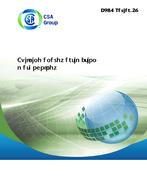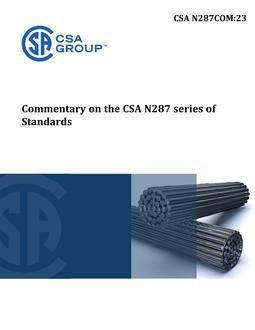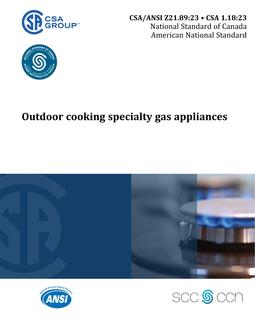
CSA C873 Series-15
- Comments Off on CSA C873 Series-15
- CSA
Click here to purchase
C873 SERIES-15 – Building energy estimation methodology
Preface
This is the second edition of the CSA C873 Series of Standards, Building energy estimation methodology. It supersedes the previous edition published in 2014. This Series of Standards consists of the following Standards: (a) the second edition of CSA C873.0, Definitions and general requirements for the calculation of energy loads, energy consumption, and source energy for heating, cooling, ventilation, domestic hot water, and lighting in buildings; (b) the first edition of CSA C873.1, General balancing procedures, terms and definitions, zoning, and evaluation of energy types; (c) the second edition of CSA C873.2, Energy loads for heating and cooling of building zones; (d) the second edition of CSA C873.3, Energy loads for conditioning air; (e) the second edition of CSA C873.4, Energy consumption for lighting; (f) the first edition of CSA C873.5, Energy consumption for heating systems; (g) the second edition of CSA C873.7, Energy consumption for air-handling and air-conditioning systems; (h) the second edition of CSA C873.8, Energy consumption for domestic hot-water systems; (i) the first edition of CSA C873.9, Energy consumption and source energy for combined heat and power plants; and (j) the second edition of CSA C873.10, Boundary conditions of use — Climatic data. This edition of the CSA C873 Series incorporates the following changes: (a) CSA C873.0: Updates to Tables 3 and 9 to align with revisions in CSA C873.3 and CSA C873.10; (b) CSA C873.2: Update to Table 3 to align with NECB (National Energy Code for Buildings in Canada); (c) CSA C873.3: Replaced Clause 7 with a formula-based procedure. Added procedure to Clause 7 for constant volume single zone systems; (d) CSA C873.4: Minor modifications to align with NECB; (e) CSA C873.7 and CSA C873.8: Minor modifications to align with revisions to CSA C873.3; and (f) CSA C873.10: Addition of “Outdoor air humidity ratio” into Tables 2—7 to support the formula-based humidification procedure changes in CSA C873.3. CSA C873.0 provides requirements that are common to some or all of the Standards of the CSA C873 Series. Wherever possible, individual Standards make reference to the relevant clauses in CSA C873.0. These Standards provide a methodology for assessing the overall energy efficiency of buildings. The calculations enable all energy quantities required for the purpose of heating, domestic hot-water heating, ventilation, air conditioning, and lighting of buildings to be assessed. CSA gratefully acknowledges that the development of the CSA C873 Series of Standards was made possible, in part, by the financial support of BC Hydro, Manitoba Hydro, the Independent Electricity System Operator (IESO) , Efficiency One, Nova Scotia- Department of Energy, Quebec Hydro, the Ontario Ministry of Energy, the Canadian Electricity Association (CEA) and Sask Power. ——————————————————————————————————————————– C873.0-15 – Building energy estimation methodology — Part 0 — Definitions and general requirements for the calculation of energy loads, energy consumption, and source energy for heating, cooling, ventilation, domestic hot water, and lighting in buildings
Scope
1.1 This Standard specifies general requirements such as reference publications, definitions, abbreviations, symbols, and subscripts used in the other Standards in the CSA C873 Series. 1.2 This Standard is intended to be used in conjunction with the other Standards in the CSA C873 Series to form a complete Standard. 1.3 In CSA Standards, “shall” is used to express a requirement, i.e., a provision that the user is obliged to satisfy in order to comply with the standard; “should” is used to express a recommendation or that which is advised but not required; “may” is used to express an option or that which is permissible within the limits of the standard; and “can” is used to express possibility or capability. Notes accompanying clauses do not include requirements or alternative requirements; the purpose of a note accompanying a clause is to separate from the text explanatory or informative material. Notes to tables and figures are considered part of the table or figure and may be written as requirements. Annexes are designated normative (mandatory) or informative (non-mandatory) to define their application. ——————————————————————————————————————————– C873.1-15 – Building energy estimation methodology — Part 1 — General balancing procedures, terms and definitions, zoning, and evaluation of energy types
Scope
1.1 This Standard covers the procedures for calculating the energy loads, energy consumption, and source energy for heating, cooling, lighting, and the domestic hot-water supply of buildings. 1.2 This Standard describes the overall calculation procedure. ——————————————————————————————————————————– C873.2-15 – Building energy estimation methodology — Part 2 — Energy loads for heating and cooling of building zones
Scope
1.1 This document specifies methods of calculating the energy loads for heating and cooling of the section of the building being assessed. The calculations are based on a specific zone of the building defined according to its intended use. 1.2 This Standard describes procedures that are suitable for calculating the energy loads for heating of building zones which have only heating, as well as the energy loads for heating and cooling of building zones which are served by both heating and cooling systems. ——————————————————————————————————————————– C873.3-15 – Building energy estimation methodology — Part 3 — Energy loads for conditioning air
Scope
1.1 This Standard determines the energy loads for thermal air conditioning (useful energy), as well as the energy consumption for air transport in ventilation and air-conditioning systems (HVAC systems) that partly use external air. 1.2 This Standard provides a methodology to determine the energy loads of ventilation systems and air-heating systems for non-residential buildings. The calculation procedure described in this Standard allows for the evaluation of the heating, cooling, and humidification loads for a large variety of conventional ventilation arrangements. For special system designs not covered by this procedure, the heating, cooling, and humidification loads must be directly calculated using an hourly analysis. ——————————————————————————————————————————– C873.4-15 – Building energy estimation methodology — Part 4 — Energy consumption for lighting
Scope
1.1 This Standard specifies a method of verifying the monthly and annual energy consumption for lighting in non-residential buildings. 1.2 This Standard provides a methodology for calculating the electrical energy consumption of the electrical lighting system, as well as accounting for daylighting. ——————————————————————————————————————————– C873.5-15 – Building energy estimation methodology — Part 5 — Energy consumption for heating systems
Scope
1.1 This Standard determines the energy consumption of the heating systems and their subsystems (control and emission, distribution, storage, and generation). 1.2 This Standard provides a methodology for calculating the energy consumption for heating provided to the air-handling system, zone coils, and absorption chillers. The auxiliary energy and the uncontrolled internal heat gains from the heating system are also calculated. ——————————————————————————————————————————– C873.7-15 – Building energy estimation methodology — Part 7 — Energy consumption for air-handling and air-conditioning systems
Scope
1.1 This Standard provides a method of calculating energy consumption for heating, ventilation, and air-conditioning systems. 1.2 This Standard specifies requirements for materials, quality of work, dimensions, sustained pressure, environmental stress cracking, and markings. ——————————————————————————————————————————– C873.8-15 – Building energy estimation methodology — Part 8 — Energy consumption for domestic hot-water systems
Scope
1.1 This Standard describes the calculation of energy consumption of domestic hot-water systems and their subsystems (control and emission, distribution, storage, and generation). 1.2 This Standard provides a methodology for calculating the energy consumption for domestic hot-water heating. The auxiliary energy and the uncontrolled internal heat gains from the domestic hot-water heating system are also calculated. ——————————————————————————————————————————– C873.9-15 – Building energy estimation methodology — Part 9 — Energy consumption and source energy for combined heat and power plants
Scope
This Standard describes a calculation procedure to determine the energy consumption for heat generation in a process involving cogeneration or combined heat and power plants. ——————————————————————————————————————————– C873.10-15 – Building energy estimation methodology — Part 10 — Boundary conditions of use — Climatic data
Scope
This Standard specifies the boundary conditions for non-residential buildings and provides reference climatic data for Canada.
Product Details
- Edition:
- 2nd
- Published:
- 11/01/2015
- ISBN(s):
- 9781488301056
- Number of Pages:
- 1024
- File Size:
- 1 file , 15 MB
- Product Code(s):
- 2424011, 2424011, 2424011



